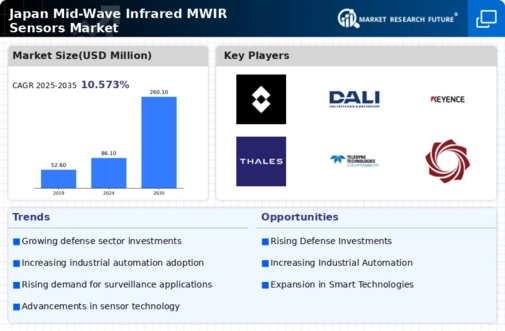Rising Focus on Energy Efficiency
The mid wave-infrared-mwir-sensors market is also being propelled by a growing focus on energy efficiency in Japan. As energy costs rise and environmental concerns become more pressing, industries are seeking innovative solutions to reduce energy consumption. Mid wave-infrared sensors can play a pivotal role in monitoring energy usage and optimizing processes in real-time. The Japanese government has set ambitious targets to reduce energy consumption by 20% by 2030, which is likely to drive the adoption of energy-efficient technologies, including mid wave-infrared sensors. This trend may result in a notable increase in market demand, as companies strive to meet regulatory requirements and enhance sustainability.
Expansion of Smart City Initiatives
Japan's commitment to developing smart cities is driving the mid wave-infrared-mwir-sensors market forward. These initiatives aim to integrate technology into urban infrastructure, enhancing the quality of life for residents. Mid wave-infrared sensors are essential for applications such as traffic monitoring, environmental sensing, and public safety. The Japanese government has earmarked ¥30 billion for smart city projects, which are expected to create a substantial demand for advanced sensing technologies. As cities evolve into smart ecosystems, the mid wave-infrared-mwir-sensors market is likely to benefit from increased adoption in various urban applications, potentially leading to a market growth of 10% by 2027.
Growing Demand for Industrial Automation
The mid wave-infrared-mwir-sensors market is significantly influenced by the increasing demand for industrial automation in Japan. As industries strive for greater efficiency and productivity, the integration of advanced sensing technologies becomes paramount. Mid wave-infrared sensors are particularly suited for applications in manufacturing processes, where they can monitor temperature and detect gases. The market for industrial automation in Japan is projected to reach ¥1 trillion by 2026, with mid wave-infrared sensors playing a crucial role in this transformation. This growing trend is likely to propel the mid wave-infrared-mwir-sensors market, as companies seek to enhance operational efficiency through automation.
Increased Investment in Research and Development
The mid wave-infrared-mwir-sensors market in Japan is experiencing a surge in investment directed towards research and development. This trend is primarily driven by the need for advanced sensing technologies across various sectors, including automotive and healthcare. The Japanese government has allocated substantial funding, estimated at ¥50 billion, to support innovation in sensor technologies. This financial backing is likely to enhance the capabilities of mid wave-infrared sensors, making them more efficient and versatile. As a result, the market is expected to witness a compound annual growth rate (CAGR) of approximately 8% over the next five years, indicating a robust growth trajectory fueled by R&D initiatives.
Advancements in Defense and Security Technologies
The mid wave-infrared-mwir-sensors market is witnessing growth due to advancements in defense and security technologies in Japan. The government is investing heavily in enhancing national security measures, which includes the integration of sophisticated sensing technologies. Mid wave-infrared sensors are crucial for surveillance, reconnaissance, and threat detection applications. With defense spending projected to increase by 5% annually, the demand for advanced sensors is expected to rise correspondingly. This focus on national security is likely to create new opportunities for the mid wave-infrared-mwir-sensors market, as defense contractors seek to incorporate cutting-edge technologies into their systems.



















Leave a Comment